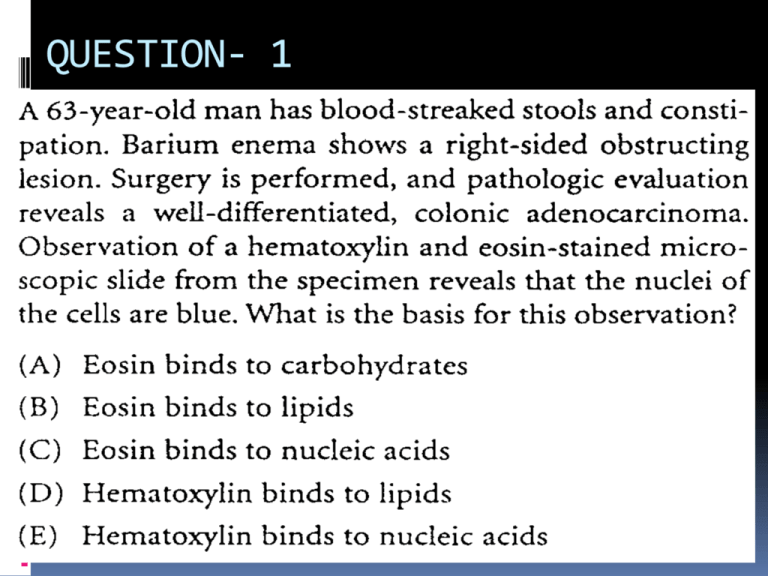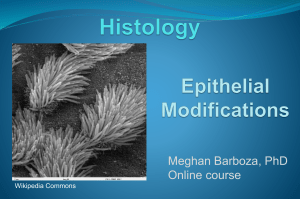HISTOLOGY USMLE
advertisement

QUESTION- 1 Types of Epithelium QUESTION-2 GAP JXN Zonula adherens Neural tube defects (NTD) In the apical part of the cells, the actin filament bundles contract, narrowing the cells at their apical ends. The position of the zonula adherens, forming a contractile ring around the circumference of the cell, coupled with the contractile nature of the actin microfilament bundles is ideal for regulating morphogenetic changes. Blistering disease (genetic defects in desmosomal proteins ) Pemphigus vulgaris or Pemphigus foliaceus Bullous pemphigoid Antibodies against hemidesmosome results in Bullous pemphigoid Q Which component of an intercalated disc provides an attachment site for actin filaments in cardiac muscle? A. Sarcoplamic reticulum B. Zonula occludens C. Fascia adherens D. Gap junction E. Tight junction Q Which of the following functions in metabolic coupling between adjacent cells? A. Tight junction B. Desmosomes C. Gap junction D. Zonula adherens E. hemidesmosomes Q Your patient has a deficiency in the ATPase motor protein dynein. Which of the following would most likely be seen in the patient? A. Anemia due to destruction of multiple misshaped RBCs by the spleen B. Dizziness and sensorineural hearing deficits C. Decreased absorption of nutrients by duodenal columnar epithelial cells D. Immotile sperm E. An increase in glial fibrillary acidic protein in astrocytes Structure of cilia -nine + two microtubules _ axoneme -- organised from basal body CLINICAL CORRELATION An 11-year-old boy presents with ciliary dyskinesia, sinusitis, and bronchiectasis. He has had persistent infections and otitis media since birth. A PA radiograph shows dextrocardia, and he has a negative saccharin test. In the cross-section of the cilium shown below, which of the following is primarily affected in this disorder? a. Structure A b. Structure B c. Structure C d. Structure D e. Structure E A male child is born with an absence of the normal structure labeled between the arrows; inclusions of that structure are found within the cells in the photomicrograph. He presents with refractory diarrhea and is chronically dependent on parenteral nutrition. What is the primary function of the structure labeled between the arrows in the photomicrograph below? a. Extensive movement of substances over cell surfaces b. Increase in surface area for absorption c. Cell motility d. Transport of intracellular organelles through the cytoplasm e. Stretch Question A mother brings her son to the pediatrics clinic. The child rapidly developed extensive blistering of the skin shortly after birth. He has painful erosions of the oral mucosa and has refused ingestion. He has also had a history of recurrent infections, with sepsis, on one occasion. Antigen mapping of a skin biopsy shows a split within the lamina lucida of the epidermal basement membrane, and junctional epidermolysis bullosa (JEB) was the diagnosis. In which specific layer of the accompanying electron micrograph (next slide) would you expect to see the disruption? Question A mother brings her son to the pediatrics clinic. The child rapidly developed extensive blistering of the skin shortly after birth. He has painful erosions of the oral mucosa and has refused ingestion. He has also had a history of recurrent infections, with sepsis, on one occasion. Antigen mapping of a skin biopsy shows a split within the lamina lucida of the epidermal basement membrane, and junctional epidermolysis bullosa (JEB) was the diagnosis. In which specific layer of the accompanying electron micrograph (next slide) would you expect to see the disruption? Epidermolysis bullosa blistering of skin Q Which glycoprotein functions to bind cells at a hemidesmosome to an underlying basal lamina? A. Entactin B. Heparin sulphate C. Fibronectin D. Integrin E. tenascin A 48-year-old man has hepatic cancer that is unresponsive to standard therapy. He enrolls in a clinical study of a novel chemotherapeutic agent that, as a side effect, blocks kinesin, a component of the cellular microtubular transport system. One week later, he develops skeletal muscle weakness. An alteration in which of the following components of the neuromuscular junction is the most likely cause of the muscle weakness? (A) A decrease in the number of postsynaptic neurotransmitter receptors (B) A decrease in the number of presynaptic neurotransmitter vesicles (C) A decrease in the presynaptic neuron calcium permeability (D) Impaired α-motoneuron action potential conduction (E) Impaired skeletal muscle action potential conduction A new drug is developed that prevents the demyelinization occurring in the progress of multiple sclerosis. The drug protects the cells responsible for the synthesis and maintenance of myelin in the central nervous system. These cells are most likely which of the following? (A) Astrocyte (B) Ependymal cell (C) Microglial cell (D) Oligodendrocyte (E) Schwann cell Defects in the production of kinesin might result in A. Vertigo B. Inability of axons to transport substances in the anterograde direction C. Respiratory distress D. Inability of axon terminals to take up calcium E. Reduced fertility Axons found around the area indicated by the arrow in the figure above are myelinated by A. astrocytes B. dorsal root ganglion cells C. microglia D. oligodendrocytes E. Schwann cells An oophorectomized monkey is treated with high doses of estrogen. Which of the following changes is most likely to occur in the endometrium after 1 year of treatment? (A) Atrophy (B) Hyperplasia (C) Hypertrophy (D) Hypoplasia (E) Metaplasia 2. Which of the following muscle cell components helps spread the depolarization of the muscle cell membranes throughout the interior of muscle cells? (A) Actin (B) Myosin (C) T tubule (D) Tropomyosin (E) Troponin (F) Z disk An experiment is conducted in which the mitochondrial content of various tissues is studied. It is found that the mitochondrial content is directly proportional to the amount of energy one cell is required to generate and expend. The mitochondrial content is most likely greatest in which of the following types of cells? (A) Cardiac muscle cells (B) Chondrocytes (C) Endothelial cells (D) Epidermal cells (E) Hepatocytes (F) Osteocytes (G) White adipocytes Which of the following is the correct sequence of events in the initiation of contraction of a skeletal muscle fiber? Depolarizati Conformatio on of nal change in sarcolemma troponintropomyosin complex Release of Ca2+ from sarcoplasmi c reticulum Propagatio n into transverse tubules Acetylcholi ne binding to receptors A 1 2 3 4 5 B 2 5 4 3 1 C 3 5 2 4 1 D 4 2 5 3 1 E 5 3 4 1 2 A pathologist uses monoclonal antibodies against several intermediate filament proteins and finds that a tumor section stains positive for cytokeratin only. The tumor most likely originated from which of the following tissues? (A) Connective (B) Epithelial (C) Glial (D) Muscle (E) Neural






